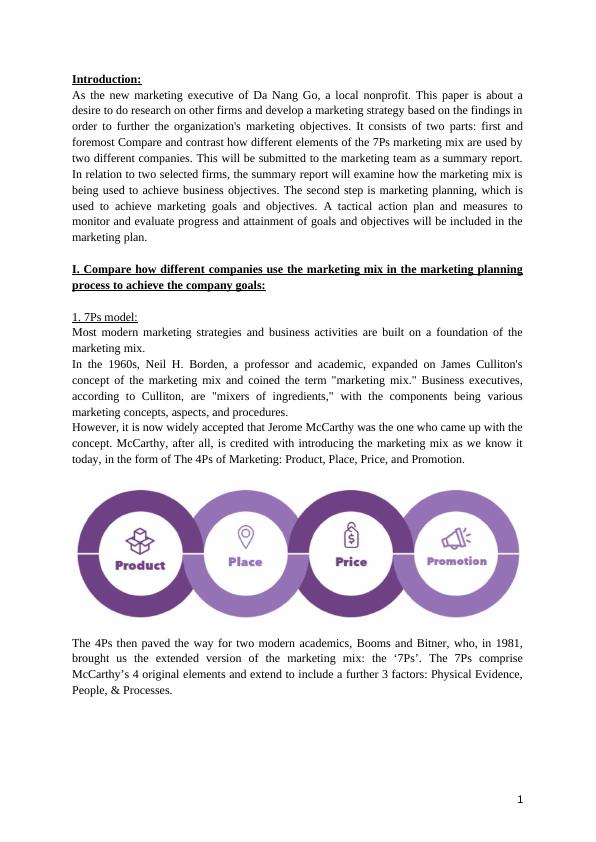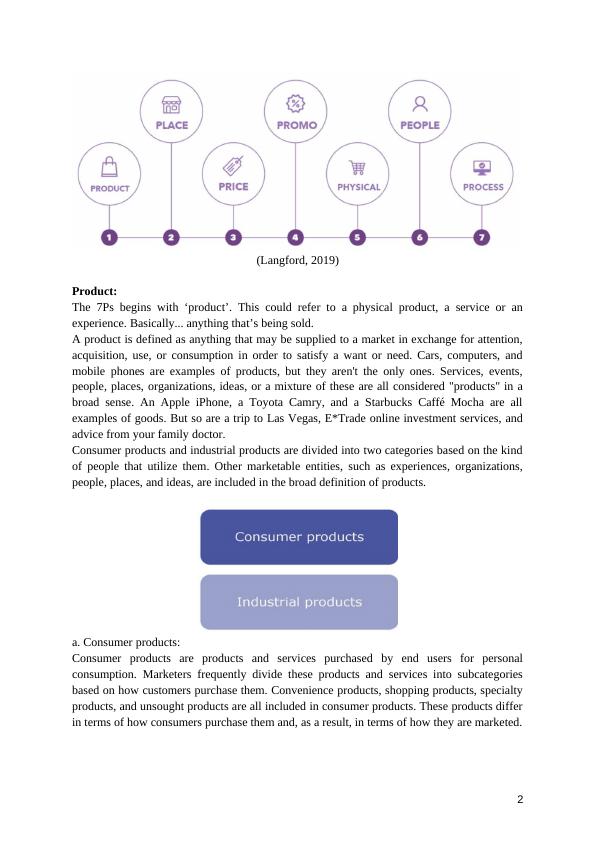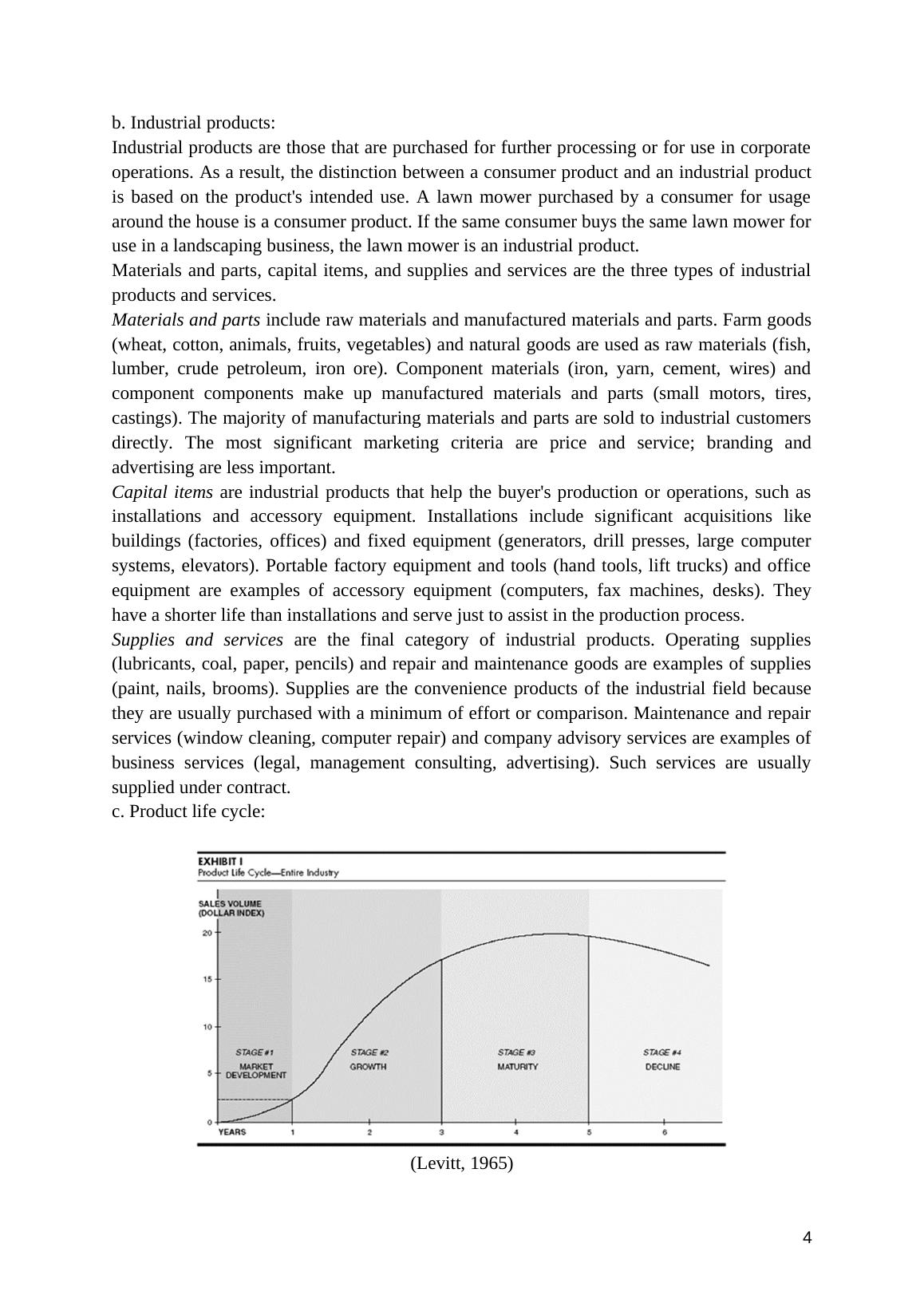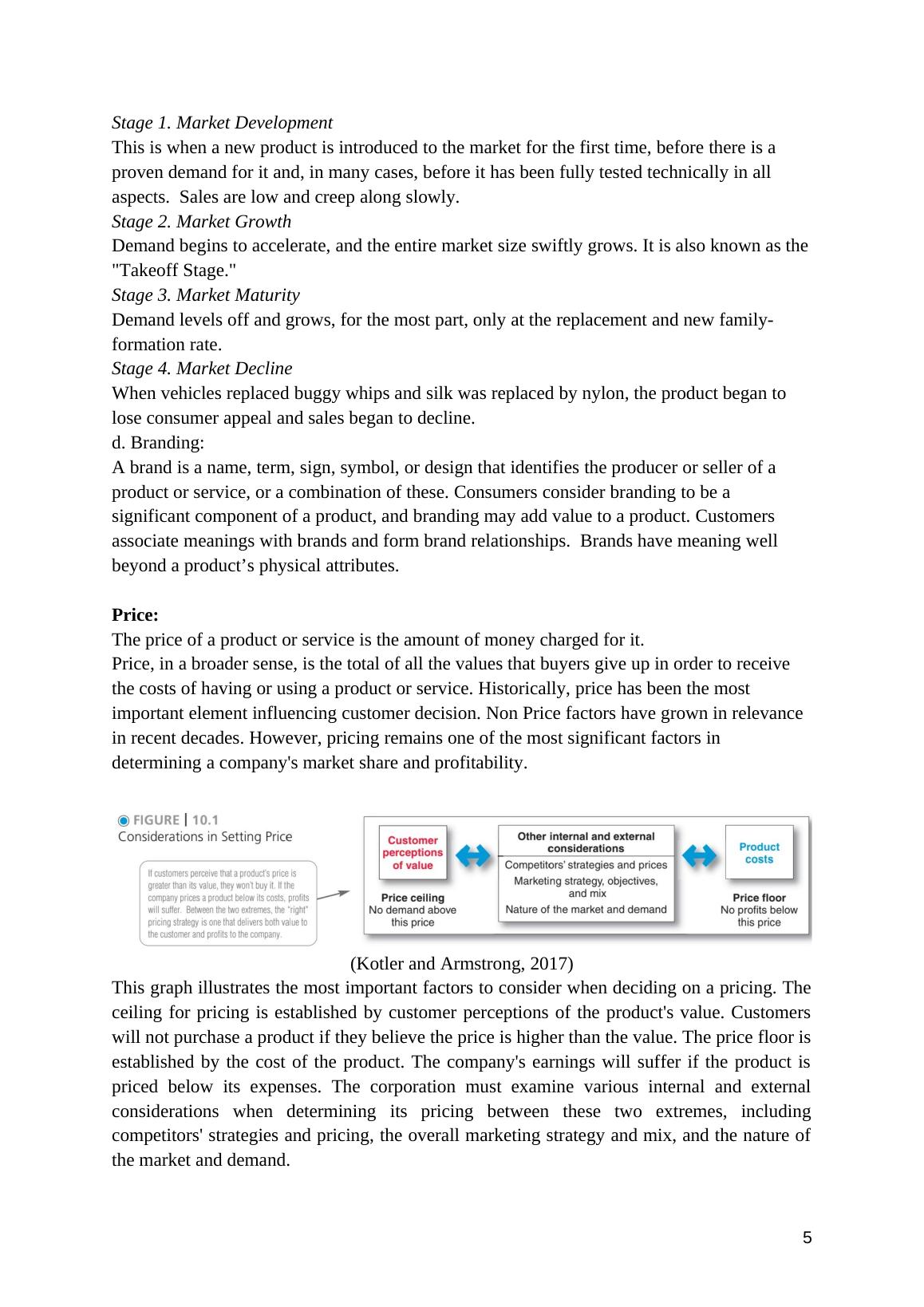Marketing Mix and The 7 Ps of Marketing - Assignment
26 Pages10280 Words35 Views
Added on 2021-11-23
Marketing Mix and The 7 Ps of Marketing - Assignment
Added on 2021-11-23
ShareRelated Documents
Introduction:
As the new marketing executive of Da Nang Go, a local nonprofit. This paper is about a
desire to do research on other firms and develop a marketing strategy based on the findings in
order to further the organization's marketing objectives. It consists of two parts: first and
foremost Compare and contrast how different elements of the 7Ps marketing mix are used by
two different companies. This will be submitted to the marketing team as a summary report.
In relation to two selected firms, the summary report will examine how the marketing mix is
being used to achieve business objectives. The second step is marketing planning, which is
used to achieve marketing goals and objectives. A tactical action plan and measures to
monitor and evaluate progress and attainment of goals and objectives will be included in the
marketing plan.
I. Compare how different companies use the marketing mix in the marketing planning
process to achieve the company goals:
1. 7Ps model:
Most modern marketing strategies and business activities are built on a foundation of the
marketing mix.
In the 1960s, Neil H. Borden, a professor and academic, expanded on James Culliton's
concept of the marketing mix and coined the term "marketing mix." Business executives,
according to Culliton, are "mixers of ingredients," with the components being various
marketing concepts, aspects, and procedures.
However, it is now widely accepted that Jerome McCarthy was the one who came up with the
concept. McCarthy, after all, is credited with introducing the marketing mix as we know it
today, in the form of The 4Ps of Marketing: Product, Place, Price, and Promotion.
The 4Ps then paved the way for two modern academics, Booms and Bitner, who, in 1981,
brought us the extended version of the marketing mix: the ‘7Ps’. The 7Ps comprise
McCarthy’s 4 original elements and extend to include a further 3 factors: Physical Evidence,
People, & Processes.
1
As the new marketing executive of Da Nang Go, a local nonprofit. This paper is about a
desire to do research on other firms and develop a marketing strategy based on the findings in
order to further the organization's marketing objectives. It consists of two parts: first and
foremost Compare and contrast how different elements of the 7Ps marketing mix are used by
two different companies. This will be submitted to the marketing team as a summary report.
In relation to two selected firms, the summary report will examine how the marketing mix is
being used to achieve business objectives. The second step is marketing planning, which is
used to achieve marketing goals and objectives. A tactical action plan and measures to
monitor and evaluate progress and attainment of goals and objectives will be included in the
marketing plan.
I. Compare how different companies use the marketing mix in the marketing planning
process to achieve the company goals:
1. 7Ps model:
Most modern marketing strategies and business activities are built on a foundation of the
marketing mix.
In the 1960s, Neil H. Borden, a professor and academic, expanded on James Culliton's
concept of the marketing mix and coined the term "marketing mix." Business executives,
according to Culliton, are "mixers of ingredients," with the components being various
marketing concepts, aspects, and procedures.
However, it is now widely accepted that Jerome McCarthy was the one who came up with the
concept. McCarthy, after all, is credited with introducing the marketing mix as we know it
today, in the form of The 4Ps of Marketing: Product, Place, Price, and Promotion.
The 4Ps then paved the way for two modern academics, Booms and Bitner, who, in 1981,
brought us the extended version of the marketing mix: the ‘7Ps’. The 7Ps comprise
McCarthy’s 4 original elements and extend to include a further 3 factors: Physical Evidence,
People, & Processes.
1

(Langford, 2019)
Product:
The 7Ps begins with ‘product’. This could refer to a physical product, a service or an
experience. Basically... anything that’s being sold.
A product is defined as anything that may be supplied to a market in exchange for attention,
acquisition, use, or consumption in order to satisfy a want or need. Cars, computers, and
mobile phones are examples of products, but they aren't the only ones. Services, events,
people, places, organizations, ideas, or a mixture of these are all considered "products" in a
broad sense. An Apple iPhone, a Toyota Camry, and a Starbucks Caffé Mocha are all
examples of goods. But so are a trip to Las Vegas, E*Trade online investment services, and
advice from your family doctor.
Consumer products and industrial products are divided into two categories based on the kind
of people that utilize them. Other marketable entities, such as experiences, organizations,
people, places, and ideas, are included in the broad definition of products.
a. Consumer products:
Consumer products are products and services purchased by end users for personal
consumption. Marketers frequently divide these products and services into subcategories
based on how customers purchase them. Convenience products, shopping products, specialty
products, and unsought products are all included in consumer products. These products differ
in terms of how consumers purchase them and, as a result, in terms of how they are marketed.
2
Product:
The 7Ps begins with ‘product’. This could refer to a physical product, a service or an
experience. Basically... anything that’s being sold.
A product is defined as anything that may be supplied to a market in exchange for attention,
acquisition, use, or consumption in order to satisfy a want or need. Cars, computers, and
mobile phones are examples of products, but they aren't the only ones. Services, events,
people, places, organizations, ideas, or a mixture of these are all considered "products" in a
broad sense. An Apple iPhone, a Toyota Camry, and a Starbucks Caffé Mocha are all
examples of goods. But so are a trip to Las Vegas, E*Trade online investment services, and
advice from your family doctor.
Consumer products and industrial products are divided into two categories based on the kind
of people that utilize them. Other marketable entities, such as experiences, organizations,
people, places, and ideas, are included in the broad definition of products.
a. Consumer products:
Consumer products are products and services purchased by end users for personal
consumption. Marketers frequently divide these products and services into subcategories
based on how customers purchase them. Convenience products, shopping products, specialty
products, and unsought products are all included in consumer products. These products differ
in terms of how consumers purchase them and, as a result, in terms of how they are marketed.
2

(Kotler and Armstrong, 2017)
Convenience products are consumer products and services that customers usually buy
frequently, immediately, and with minimal comparison and buying effort.Laundry detergent,
candy, magazines, and fast food are just a few examples. Convenience products are often
low-cost, and marketers distribute them widely to ensure that they are available when
customers need or want them.
Shopping products are less frequently purchased consumer products and services that
customers compare carefully on suitability, quality, price, and style. Consumers spend a lot of
time and effort gathering information and comparing products and services while purchasing.
Furniture, clothing, used cars, major appliances, and hotel and airline services are among
examples. Shopping product marketers often sell their items through fewer channels but give
more comprehensive sales assistance to assist customers in their comparative shopping.
Specialty products are consumer products with unique characteristics or brand identification
for which a significant group of buyers is willing to make a special purchase effort. Specific
automobile brands, high-priced photographic equipment, fashionable clothing, and the
services of medical or legal professionals are all examples. A Lamborghini car, for example,
is a niche item because purchasers are often willing to travel great distances to obtain one.
Buyers normally do not compare specialty products. They invest only the time needed to
reach dealers carrying the wanted products.
Unsought products are consumer goods that the consumer either is unaware of or is aware of
but does not intend to purchase. Most major new innovations are unsought until the consumer
becomes aware of them through advertising. Life insurance, preplanned funeral services, and
blood donations to the Red Cross are all instances of well-known but underutilized products
and services. Unsought products, by their very nature, need a lot of advertising, personal
selling, and other marketing efforts.
3
Convenience products are consumer products and services that customers usually buy
frequently, immediately, and with minimal comparison and buying effort.Laundry detergent,
candy, magazines, and fast food are just a few examples. Convenience products are often
low-cost, and marketers distribute them widely to ensure that they are available when
customers need or want them.
Shopping products are less frequently purchased consumer products and services that
customers compare carefully on suitability, quality, price, and style. Consumers spend a lot of
time and effort gathering information and comparing products and services while purchasing.
Furniture, clothing, used cars, major appliances, and hotel and airline services are among
examples. Shopping product marketers often sell their items through fewer channels but give
more comprehensive sales assistance to assist customers in their comparative shopping.
Specialty products are consumer products with unique characteristics or brand identification
for which a significant group of buyers is willing to make a special purchase effort. Specific
automobile brands, high-priced photographic equipment, fashionable clothing, and the
services of medical or legal professionals are all examples. A Lamborghini car, for example,
is a niche item because purchasers are often willing to travel great distances to obtain one.
Buyers normally do not compare specialty products. They invest only the time needed to
reach dealers carrying the wanted products.
Unsought products are consumer goods that the consumer either is unaware of or is aware of
but does not intend to purchase. Most major new innovations are unsought until the consumer
becomes aware of them through advertising. Life insurance, preplanned funeral services, and
blood donations to the Red Cross are all instances of well-known but underutilized products
and services. Unsought products, by their very nature, need a lot of advertising, personal
selling, and other marketing efforts.
3

b. Industrial products:
Industrial products are those that are purchased for further processing or for use in corporate
operations. As a result, the distinction between a consumer product and an industrial product
is based on the product's intended use. A lawn mower purchased by a consumer for usage
around the house is a consumer product. If the same consumer buys the same lawn mower for
use in a landscaping business, the lawn mower is an industrial product.
Materials and parts, capital items, and supplies and services are the three types of industrial
products and services.
Materials and parts include raw materials and manufactured materials and parts. Farm goods
(wheat, cotton, animals, fruits, vegetables) and natural goods are used as raw materials (fish,
lumber, crude petroleum, iron ore). Component materials (iron, yarn, cement, wires) and
component components make up manufactured materials and parts (small motors, tires,
castings). The majority of manufacturing materials and parts are sold to industrial customers
directly. The most significant marketing criteria are price and service; branding and
advertising are less important.
Capital items are industrial products that help the buyer's production or operations, such as
installations and accessory equipment. Installations include significant acquisitions like
buildings (factories, offices) and fixed equipment (generators, drill presses, large computer
systems, elevators). Portable factory equipment and tools (hand tools, lift trucks) and office
equipment are examples of accessory equipment (computers, fax machines, desks). They
have a shorter life than installations and serve just to assist in the production process.
Supplies and services are the final category of industrial products. Operating supplies
(lubricants, coal, paper, pencils) and repair and maintenance goods are examples of supplies
(paint, nails, brooms). Supplies are the convenience products of the industrial field because
they are usually purchased with a minimum of effort or comparison. Maintenance and repair
services (window cleaning, computer repair) and company advisory services are examples of
business services (legal, management consulting, advertising). Such services are usually
supplied under contract.
c. Product life cycle:
(Levitt, 1965)
4
Industrial products are those that are purchased for further processing or for use in corporate
operations. As a result, the distinction between a consumer product and an industrial product
is based on the product's intended use. A lawn mower purchased by a consumer for usage
around the house is a consumer product. If the same consumer buys the same lawn mower for
use in a landscaping business, the lawn mower is an industrial product.
Materials and parts, capital items, and supplies and services are the three types of industrial
products and services.
Materials and parts include raw materials and manufactured materials and parts. Farm goods
(wheat, cotton, animals, fruits, vegetables) and natural goods are used as raw materials (fish,
lumber, crude petroleum, iron ore). Component materials (iron, yarn, cement, wires) and
component components make up manufactured materials and parts (small motors, tires,
castings). The majority of manufacturing materials and parts are sold to industrial customers
directly. The most significant marketing criteria are price and service; branding and
advertising are less important.
Capital items are industrial products that help the buyer's production or operations, such as
installations and accessory equipment. Installations include significant acquisitions like
buildings (factories, offices) and fixed equipment (generators, drill presses, large computer
systems, elevators). Portable factory equipment and tools (hand tools, lift trucks) and office
equipment are examples of accessory equipment (computers, fax machines, desks). They
have a shorter life than installations and serve just to assist in the production process.
Supplies and services are the final category of industrial products. Operating supplies
(lubricants, coal, paper, pencils) and repair and maintenance goods are examples of supplies
(paint, nails, brooms). Supplies are the convenience products of the industrial field because
they are usually purchased with a minimum of effort or comparison. Maintenance and repair
services (window cleaning, computer repair) and company advisory services are examples of
business services (legal, management consulting, advertising). Such services are usually
supplied under contract.
c. Product life cycle:
(Levitt, 1965)
4

Stage 1. Market Development
This is when a new product is introduced to the market for the first time, before there is a
proven demand for it and, in many cases, before it has been fully tested technically in all
aspects. Sales are low and creep along slowly.
Stage 2. Market Growth
Demand begins to accelerate, and the entire market size swiftly grows. It is also known as the
"Takeoff Stage."
Stage 3. Market Maturity
Demand levels off and grows, for the most part, only at the replacement and new family-
formation rate.
Stage 4. Market Decline
When vehicles replaced buggy whips and silk was replaced by nylon, the product began to
lose consumer appeal and sales began to decline.
d. Branding:
A brand is a name, term, sign, symbol, or design that identifies the producer or seller of a
product or service, or a combination of these. Consumers consider branding to be a
significant component of a product, and branding may add value to a product. Customers
associate meanings with brands and form brand relationships. Brands have meaning well
beyond a product’s physical attributes.
Price:
The price of a product or service is the amount of money charged for it.
Price, in a broader sense, is the total of all the values that buyers give up in order to receive
the costs of having or using a product or service. Historically, price has been the most
important element influencing customer decision. Non Price factors have grown in relevance
in recent decades. However, pricing remains one of the most significant factors in
determining a company's market share and profitability.
(Kotler and Armstrong, 2017)
This graph illustrates the most important factors to consider when deciding on a pricing. The
ceiling for pricing is established by customer perceptions of the product's value. Customers
will not purchase a product if they believe the price is higher than the value. The price floor is
established by the cost of the product. The company's earnings will suffer if the product is
priced below its expenses. The corporation must examine various internal and external
considerations when determining its pricing between these two extremes, including
competitors' strategies and pricing, the overall marketing strategy and mix, and the nature of
the market and demand.
5
This is when a new product is introduced to the market for the first time, before there is a
proven demand for it and, in many cases, before it has been fully tested technically in all
aspects. Sales are low and creep along slowly.
Stage 2. Market Growth
Demand begins to accelerate, and the entire market size swiftly grows. It is also known as the
"Takeoff Stage."
Stage 3. Market Maturity
Demand levels off and grows, for the most part, only at the replacement and new family-
formation rate.
Stage 4. Market Decline
When vehicles replaced buggy whips and silk was replaced by nylon, the product began to
lose consumer appeal and sales began to decline.
d. Branding:
A brand is a name, term, sign, symbol, or design that identifies the producer or seller of a
product or service, or a combination of these. Consumers consider branding to be a
significant component of a product, and branding may add value to a product. Customers
associate meanings with brands and form brand relationships. Brands have meaning well
beyond a product’s physical attributes.
Price:
The price of a product or service is the amount of money charged for it.
Price, in a broader sense, is the total of all the values that buyers give up in order to receive
the costs of having or using a product or service. Historically, price has been the most
important element influencing customer decision. Non Price factors have grown in relevance
in recent decades. However, pricing remains one of the most significant factors in
determining a company's market share and profitability.
(Kotler and Armstrong, 2017)
This graph illustrates the most important factors to consider when deciding on a pricing. The
ceiling for pricing is established by customer perceptions of the product's value. Customers
will not purchase a product if they believe the price is higher than the value. The price floor is
established by the cost of the product. The company's earnings will suffer if the product is
priced below its expenses. The corporation must examine various internal and external
considerations when determining its pricing between these two extremes, including
competitors' strategies and pricing, the overall marketing strategy and mix, and the nature of
the market and demand.
5

This graph suggests three major pricing strategies: customer value-based pricing, cost-
based pricing, and competition-based pricing.
a. Customer value-based pricing:
Customer value-based pricing bases pricing on the buyers' perceptions of value rather than
the seller's cost. Value-based pricing means that the marketer cannot design a product and
marketing program and then set the price. Price is considered along with all other marketing
mix variables before the marketing program is set.
(Kotler and Armstrong, 2017)
Value-based pricing is compared to cost-based pricing in this chart. Although costs are a
significant factor in determining prices, cost-based pricing is frequently dictated by the
product. The corporation creates what it thinks to be a good product, calculates the
production cost, and sets a price that covers the costs plus a target profit. Marketing must then
convince buyers that the product’s value at that price justifies its purchase. If the price is too
high, the corporation will have to accept lower markups or lower sales, both of which would
result in disappointing profits.
This process is reversed with value-based pricing. Customer demands and value perceptions
are first assessed by the organization. The target price is then determined based on client
perceptions of value. Decisions on what expenses may be expended and the resulting product
design are driven by the intended value and price. As a result, pricing begins with the analysis
of consumer demands and value perceptions, with the price determined to correspond to
perceived value.
Good-value pricing:
Consumer opinions on pricing and quality have changed dramatically as a result of recent
economic events. Many businesses have adjusted their pricing strategies in response to
shifting economic conditions and customer perceptions of price. Marketers are increasingly
implementing good-value pricing strategies, which give the perfect mix of quality and service
at a reasonable price.
An important type of good-value pricing at the retail level is everyday low pricing (EDLP).
EDLP entails charging a low price on a consistent basis with few or no temporary price
discounts. EDLP is used by retailers like Costco and Room & Board, which sells furniture.
Walmart is the king of EDLP, having basically invented the concept. Except for a select
monthly sale of products, Walmart promises cheap pricing on everything it offers every day.
High-low pricing, on the other hand, entails charging higher rates on a daily basis while
conducting regular promotions to temporarily cut costs on certain goods. High-low pricing is
6
based pricing, and competition-based pricing.
a. Customer value-based pricing:
Customer value-based pricing bases pricing on the buyers' perceptions of value rather than
the seller's cost. Value-based pricing means that the marketer cannot design a product and
marketing program and then set the price. Price is considered along with all other marketing
mix variables before the marketing program is set.
(Kotler and Armstrong, 2017)
Value-based pricing is compared to cost-based pricing in this chart. Although costs are a
significant factor in determining prices, cost-based pricing is frequently dictated by the
product. The corporation creates what it thinks to be a good product, calculates the
production cost, and sets a price that covers the costs plus a target profit. Marketing must then
convince buyers that the product’s value at that price justifies its purchase. If the price is too
high, the corporation will have to accept lower markups or lower sales, both of which would
result in disappointing profits.
This process is reversed with value-based pricing. Customer demands and value perceptions
are first assessed by the organization. The target price is then determined based on client
perceptions of value. Decisions on what expenses may be expended and the resulting product
design are driven by the intended value and price. As a result, pricing begins with the analysis
of consumer demands and value perceptions, with the price determined to correspond to
perceived value.
Good-value pricing:
Consumer opinions on pricing and quality have changed dramatically as a result of recent
economic events. Many businesses have adjusted their pricing strategies in response to
shifting economic conditions and customer perceptions of price. Marketers are increasingly
implementing good-value pricing strategies, which give the perfect mix of quality and service
at a reasonable price.
An important type of good-value pricing at the retail level is everyday low pricing (EDLP).
EDLP entails charging a low price on a consistent basis with few or no temporary price
discounts. EDLP is used by retailers like Costco and Room & Board, which sells furniture.
Walmart is the king of EDLP, having basically invented the concept. Except for a select
monthly sale of products, Walmart promises cheap pricing on everything it offers every day.
High-low pricing, on the other hand, entails charging higher rates on a daily basis while
conducting regular promotions to temporarily cut costs on certain goods. High-low pricing is
6

End of preview
Want to access all the pages? Upload your documents or become a member.
Related Documents
486_Marketing Essentials Assignmentlg...
|22
|7338
|87
Practical Digital Marketing - BMP3006lg...
|12
|2690
|239
Marketing Essentials Assignment Copy - EE Limitedlg...
|12
|2421
|201
Introduction to Marketing: Extended Marketing Mix, SWOT Analysis, Ansoff Growth Matrix, and Global Marketinglg...
|9
|2100
|244
Research on Marketing Mix elementlg...
|18
|4235
|55
The Role of Marketing in Satisfying Customer Needslg...
|10
|2263
|188
